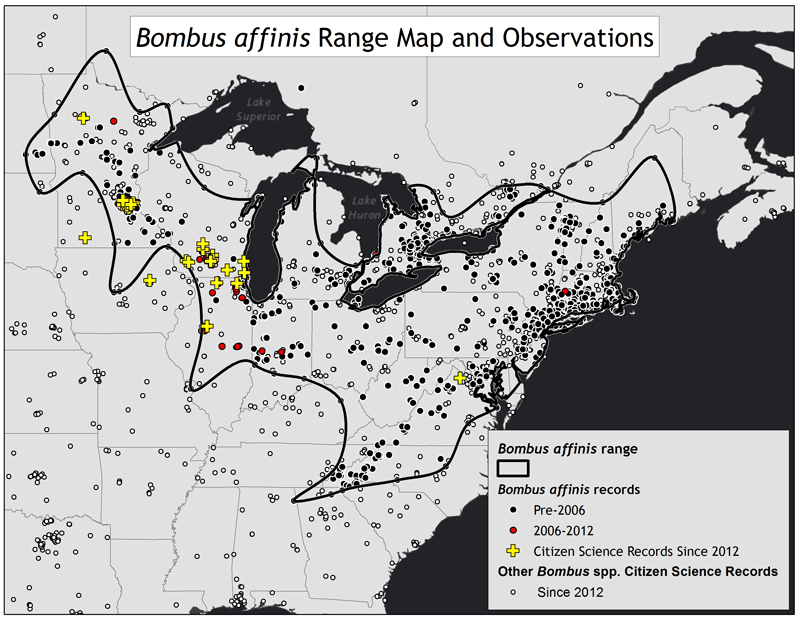This news comes after more than a decade of work by the Xerces Society and our partners: Scientists, farmers and land managers, filmmakers, advocates, and community members who all care about native bees and their plight.
In response to a petition from the Xerces Society, on Wednesday, January 11, the U.S. Fish and Wildlife Service announced a final rule to list the rusty patched bumble bee (Bombus affinis) as an endangered species under the Endangered Species Act, making it the first bee in the continental U.S. to be federally protected. This news gives me tremendous hope for the recovery of this bee, and comes after more than a decade of work by the Xerces Society and our partners: Scientists, farmers and land managers, filmmakers, advocates, and community members who all care about native bees and their plight.
The rusty patched bumble bee is among the most endangered of our widespread native bee species. Once common in eastern states from Maine to Georgia and west to North Dakota, it has been lost from about 90% of its historic range, and is far less abundant than it used to be where it still exists (mostly in the Upper Midwest). It is no longer around to pollinate the wildflowers and crops to the extent that it once did.

Thanks to the decision by the USFWS the rusty patched bumble bee will now be protected from activities that could cause it to go extinct. In addition, the USFWS will have the authority to develop and implement a recovery plan.
This bee’s initial decline was probably caused by pathogens that were distributed by commercially raised bumble bees to wild populations. Bumble bees are reared commercially and shipped between states to pollinate greenhouse tomatoes and a wide variety of other crops, often in open fields, yet regulations to ensure that the bumble bees sold are free of diseases simply don’t exist. The loss of flower-rich habitat from this bee’s range may have also played a role in its decline.
Now that its populations are small and isolated, the rusty patched bumble bee is vulnerable to other threats. Perhaps most concerning to its survival is the widespread use of insecticides near the remaining populations, in particular a group of persistent insecticides called neonicotinoids. These are long lasting, highly toxic to bumble bees, and used extensively within the rusty patched bumble bee’s range. To compound this, neonicotinoids are often used prophylactically, applied as a seed treatment to crops when pests have not yet been documented.

In the final rule, the USWS outlined activities that may result in a violation of the Endangered Species Act, including: “the unauthorized use of herbicides, pesticides, or other chemicals in habitats in which the rusty patched bumble bee is known to occur”, as well as “unauthorized release of nonnative species or native species that carry pathogens, diseases, or fungi that are known or suspected to adversely affect rusty patched bumble bee where the species is known to occur,” which presumably refers to managed bees. In addition, the USFWS states that “unauthorized modification, removal, or destruction of the habitat (including vegetation and soils) in which the rusty patched bumble bee is known to occur” may result in a violation of the ESA.
This kind of conservation success isn’t achieved quickly. This week’s announcement comes after nearly ten years of effort by Xerces scientists and our many collaborators. The Xerces Society has been at the forefront of pollinator conservation for decades, building strong partnerships with the federal government and state and local agencies as well as with farmers, gardeners and other landowners to create change in our landscape. Although ESA listing is a very good first step, the hard work of actually recovering the species lies ahead. The Xerces Society will continue to work with our incredible partners across the range of this species to better understand, protect, and manage habitat on farms, roadsides, parks, and gardens for the benefit of this and other important pollinators. Whether you grow food or just eat it, value vibrant wildlands or just relax in your garden, recovery of this species is in everyone’s best interest—and we Xerces will roll up our sleeves to join you for the work ahead.
I am optimistic that Endangered Species Act protection will serve to protect this bee from the most significant threats it faces: pathogens from managed bees, the indiscriminate use of pesticides within its range, and habitat loss. These protections, along with increased efforts to restore pollinator habitat, will undoubtedly help a variety of other at-risk pollinators, from the monarch butterfly to the more than one quarter of North America’s bumble bees that are threatened with extinction. As we embark upon a very uncertain future for the conservation of wild animals and the places they inhabit, this announcement gives me hope that we, as a society, can make—and fulfill—a commitment to saving one of America’s most endangered pollinators.
Further Reading
Learn more about the Xerces Society's advocacy work.
Read more about the Xerces Society's Endangered Species Conservation Program.




